Ever Had A “Great Idea” Only For Reality To Beat The Sh%* Out Of You For It?
Have you ever had a great idea—only for reality to beat the sh%* out of your confidence in it?
I started Growbo.com in 2010.
I was broke then. I had less than $200 in the bank.
My previous software startup, BlueSkyLocal, had failed.
I had moved home to live with family. I figured I’d look for a job rather than keep going.
But I felt like a part of me was dying each time I walked into an interview.
I felt I had given up—given up on a dream that was vital to who I wanted to be.
I felt defeated.
“What had I done wrong?” I wondered.
Receive a copy of this article to read later
2010: Just Do It.
“The best time to plant a tree was 20 years ago. The second best time is now.”– Chinese Proverb
I journaled at night. I read books about the great, enduring companies that grew large, some lasting over 100 years.
Like American Express, or General Electric for instance.
As I wrote and reflected, I remembered this one time, back when I was a teenager. I thought the high school experience was shallow and a waste of time.
So I made a plan to drop out.
I didn’t know much about entrepreneurship, but I was passionate about creating stuff. Namely, writing fiction and painting.
My plan was: (1) Drop out, (2) Write and paint every day, (3) Make millions.
Being as I wasn’t an adult (and didn’t have a car), I was easily persuaded to stay in school by my family and teachers.
At the end of my college career I decided to go against the advice of my two mentors (who were also entrepreneurs):
“We think you should get a job, work in corporate for a while. Get experience.”
I moved forward with BlueSkyLocal anyway, which was a web-based SaaS product.
It didn’t work out.
“What had I done wrong?” I kept wondering.
“You need to apply to more jobs,” my parents urged.
After hearing it enough times, it seemed logical. I was living rent-free and I didn’t want to be one of “those people”.
My fourth job interview was in the city. I put on a suit (not my style at all) and rode the train in.
The interview went fine. I knew they would offer me the job.
I called up a friend as I rode the elevator down from the interview. He was in the area and so we met at a diner across the street.
We talked a bit. He knew me well enough to know my heart was not in it.
He asked me a simple question: “If you don’t want to do it, then why are you?”
I fumbled over my words, I said something like “well, I need to pay the bills, have to grow up and earn a salary.”
He shook his head and stopped me. I’ll never forget what he said next because it was like his words snapped me out of a spell.
“I think that’s a load of bullshit, Matt.”
It shocked me because I knew it was true.
I laid awake that night thinking and coaching myself on “what next?”
I wrote this in my journal—exactly 8 years ago from today:
April 30th, 2010 ~10:30 PM — “Shaping / Shaped By”
You have a choice, so does everyone else. You can choose to be shaped by reality (by your environment, by your friends and family, by societal expectations) or you can choose to shape reality, to build your own environment, craft your own expectations, to think for yourself.
I am successful and my success will only expand exponentially from this point, because I am aware of my limits, and the fact that, in a sense, they are only my limits because I choose for them to be. Therefore all (or many) limits are a choice and I can choose to exceed them or even remove them completely.

A few days after that I decided I’d give the startup thing another shot.
It wasn’t simply: “Well, let’s just give it a go!” :: shrug!::
It was a decision based on realistic planning. I knew how we would generate revenue and profit in the short term, and I knew the market was there.
(I knew because I made just as much money in college designing a few websites as I had from my first startup.)
There was something profound in making the decision. I felt as if I had armor on. It deflected all doubts.
I would build a company. Not just a web app this time. A company that made an impact.
“You’re an asshole,” my girlfriend at the time had told me.
I had just explained to her I would not be searching for a job any longer and I would focus on my startup. But she had a “normal” job at an investment bank in the city.
I left a note breaking up with her the following morning.
“You seem lazy,” my parents said. “You don’t seem very ambitious… You’re throwing your life away.”
Two weeks later I was holding a check for $5,000 in my hands for our first web design client. This was more money than my last startup had earned in 6 months.
I moved out a week later.
I pasted the quote from my journal to the wall in front of my desk, along with a couple of the other gems above.
Key Lessons:
- It’s corny and cliche but, you have to believe in yourself. Your sense of belief defines what you can or cannot do. It shapes your reality, it shapes your most important life decisions.
- Be willing to say “no” to everyone. Almost all criticism or “life advice” is reflective of the person giving it, and not reflective of its own quality or merit.
2011 - 2012: Money In, Money Out
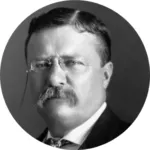 “It is not the critic who counts; not the man who points out how the strong man stumbles, or where the doer of deeds could have done them better. The credit belongs to the man who is actually in the arena, whose face is marred by dust and sweat and blood, who strives valiantly; who errs and comes short again and again; because there is not effort without error and shortcomings; but who does actually strive to do the deed; who knows the great enthusiasm, the great devotion, who spends himself in a worthy cause, who at the best knows in the end the triumph of high achievement and who at the worst, if he fails, at least he fails while daring greatly. So that his place shall never be with those cold and timid souls who know neither victory nor defeat.”
“It is not the critic who counts; not the man who points out how the strong man stumbles, or where the doer of deeds could have done them better. The credit belongs to the man who is actually in the arena, whose face is marred by dust and sweat and blood, who strives valiantly; who errs and comes short again and again; because there is not effort without error and shortcomings; but who does actually strive to do the deed; who knows the great enthusiasm, the great devotion, who spends himself in a worthy cause, who at the best knows in the end the triumph of high achievement and who at the worst, if he fails, at least he fails while daring greatly. So that his place shall never be with those cold and timid souls who know neither victory nor defeat.”
- Theodore Roosevelt
(This is one of the quotes that made me want to start a business)
I put my head down and worked my ass off.
When I needed reassurance, I read the journal quote pasted to the wall in front of me.
When I needed energy, I read the negative quotes. They made me angry, and the anger fueled my energy to work 12 hours a day and longer sometimes.
I remember going food shopping in those early days. I had so little money, I remember thinking that when I could buy food without worrying about the cost—then I’d be “rich”.
I ate peanut butter and jelly sandwiches for a while.
I didn’t go out, except to the gym.
I remember one time crying myself to sleep in the second month because I thought I was going to be evicted. At the time, I couldn’t afford rent.
The next day, I got up and went out to a networking event. I closed a deal with a new client.
I kept closing deals for new projects...
Ten months after starting we had $35,000 of cash profits in the bank.
At our peak that first year we were generating $20,000 to $35,000 revenue per month. We had a full-time team of five, with three others who were part-time.
We generated $106,000 in revenue that first year, with close to 50% gross profit margins.

The money was great, but it was validation that I had said “NO” to the doubts of others and succeeded.
It was also validation for the bigger vision: to build a great company.
Our mission:
Accelerate Creativity & The Entrepreneurial Spirit
And the company values we were building on (and still have to this day):
- Relentless Self-Improvement.
- Honor Your Ability to Create.
- Enjoyment, because life may be shorter than you realize.
I enjoyed talking about these ideas and planning for the future with the team and new hires.
Life was good. We were growing fast...
Around this time I had an idea for a web application for email marketing.
I coded the first version myself.
Then, once I had the team, I naively let them take over. We poured tens-of-thousands into it. Unfortunately, we never officially launched it, though we did have a few clients as paying customers.
We were forced to stop working on because just then we lost a couple of big clients.
One went on a spending freeze. They were a startup too. I was informed of this when I called the accountant to ask about our invoice which was two weeks late.
“F%$K YOU!” she yelled and hung up the phone.
I’m not kidding, that happened.
One of our clients had flown us out to Beijing, China at the time. He was a “coach” (idiot) of sorts.
I went against my better judgment and let this “coach” exercise his “conflict ethics” philosophy via emails. I called our client in an effort to pay us.
We got paid… But it destroyed the relationship.
Our other contracts couldn’t make up the difference. Our payroll was recurring $16,000 every month, but our company earned money on a per project basis.
The math was simple... But I hesitated.
I considered our team members friends. They had families. And I had never fired someone.
Eventually, after our bank account was drained of much of its profits two months later, I laid off the whole team.
It worked to save the business… Barely...
Then I had to fire my best friend, someone I had known since middle school.
I had taken him on as a business partner, but we had a different vision on how to grow the company.
Mine was systems and a content marketing focused.
His was more about networking.
After I fired him he became very upset and disillusioned. Like me, he believed in the company. In his anger, he threatened to poach all of the company’s clients.
We eventually worked it out and I bought back his shares in the company.
As a startup in the position we were in, you have to act fast and decide fast. There’s no time for lengthy debates.
I had hoped that having a business partner would give me more time to focus on marketing and internal systems. Unfortunately, we didn’t complement each other in that way.
I was better able to attract and close sales on my own, without the need for debate or discussion. And it was so unbelievably necessary...
Our finances were so tight by then that at our worst moment, our bank account went negative $3,300.
I didn’t even know that was possible!
But we clawed our way back.
I woke up at 6 am every day, and did the job of five people.
Whatever it took to keep the company alive, I did it.
I hate cliches but those early days were a giant roller coaster.
It was rough, but constantly taking action helped distract me and stay focused on what mattered.
By then I knew more about what clients wanted.
Our work was always high quality, and we made money for most of our clients.
I also knew more about how to attract clients via content marketing, and I knew a bit more about how to sell.
I realized that the fatal flaw in our business was the lack of consistent leads and high overhead costs.
We had built our first sales funnel, but it wasn’t sustainable or scalable.
I pondered how to solve this problem as our bank account turned from red to black (profitable)...
Slowly…
Key Lessons:
- Focus and drive applied to a market that wants what you’re selling is deadly effective for growth.
- Know your numbers.
- Fire faster.
2013 — 2015: Press On
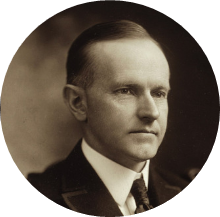 “Nothing in this world can take the place of persistence. Talent will not: nothing is more common than unsuccessful men with talent. Genius will not; unrewarded genius is almost a proverb. Education will not: the world is full of educated derelicts. Persistence and determination alone are omnipotent.”
“Nothing in this world can take the place of persistence. Talent will not: nothing is more common than unsuccessful men with talent. Genius will not; unrewarded genius is almost a proverb. Education will not: the world is full of educated derelicts. Persistence and determination alone are omnipotent.”
- Calvin Coolidge
In case you missed the hint, so much stuff can and does go wrong in starting a company.
If you’ve got startup experience, you probably already know this.
Some of it you can anticipate—e.g. Business partnerships rarely last a lifetime. You need to assume they will end at some point before they even start.
(On this point, I actually prefer not having a partner for now. It seems to complicate things. If you’re afraid to go for it alone, don’t be. Everything necessary for success is based on your ability to learn and develop your skillset. Partners can help, but they can also hinder.)
A lot of it though you just can’t anticipate. You just have to move forward.
Press on.
There will always be struggles and challenges. But make sure those challenges come of your choosing and are not borne of circumstance or of someone else.
After those first two years, I knew I wanted to move away from the project-based model of work.
I wanted to get to a point where I could focus on products.
But I wasn't sure how.
As many consultants, freelancers, and agencies know too well: project-based business models are extremely up and down, “feast or famine.”
You have to do the work, but then no one is bringing in more leads because you’re busy doing the work.
And you can’t sell more either because you need to finish the work you already have. Your capacity is fixed based on your time.
Then when the work is done, you have to hustle and run around to drum up client leads. Otherwise, you can’t cover your expenses.
It’s a very, very unsettling pattern to get trapped in.
At this was when sales funnels were starting to become a thing. I wrote one of the first, most comprehensive, and most popular articles on the subject. But this was still before productized services.
With revenue back on track, I did the smartest / riskiest thing I could:
I stopped selling services completely.
In hindsight, this was a complete impractical move. I thought it was a distraction.
I thought I could make it work, somehow...
Stopping that allowed me to go all-in on coding this web application idea that I was certain (I had hoped) to be a huge, viral success.
I maxed out my credit card and the company cards, paid for rent and everything else with them.
I ignored “final notices” from the cable, electricity, etc. as long as possible.
Nothing would distract or deter me.
I put my head down and worked my ass off.
It had worked before, so why not now?
But unlike that first year, the mistake I didn’t realize I was making was this:
At the price points we were planning to charge, it would take an incredibly large number of customers before we were profitable.
I did one thing right though: I pre-sold the idea to about a dozen customers from the beginning.
So the idea was validated. Now I just needed to finish building it…
And I did. I coded day and night.
The idea behind the app was that people will help you increase your reach on social media if you helped them back.
I knocked out one feature after another.
The momentum was building.
And finally, we launched.
Techcrunch and others covered us.
We gained fifteen new customers that first day.
But the momentum didn’t last and the product didn’t take off.
Instead of fixing the problems (I was too close to the product and too concerned about the mounting debt / lack of income—which is a completely rational reaction), I decided to pause working on it.
I went back to selling services.
(Note that all of this is occurring over the course of weeks and months.)
I did that for a while, but the problems came up.
It was far better than in the past.
We had a solid lead generation funnel setup now. Client leads streamed in daily, requesting consultations. I would close deals over the phone.
I never had to go to networking events to drum up business.
We never had to pay Google or anyone else for ads.
We weren’t at the mercy of referrals either.
Despite this positive development, the problems that popped up were:
- Lack of predictable revenue since it was project-based. Hiring and making other long term investments was nearly impossible from a risk-management standpoint.
- Scaling—How could we hire full-time in order to take on more clients? I felt adamant about not making the same costly mistakes of 2010 and 2011...
I felt stuck. But not defeated.
I knew I wanted to build products and sell them online.
As I explained though, the challenge with that — even if you charge monthly — is volume. You have to be able to cover your overhead.
And there’s a reason why the CEO of Constant Contact, the Founder of BareMetrics and other SaaS founders call their growth curve:
“The long, slow SaaS ramp of death.”
To get to the point where I could work on products, it seemed I had to solve this problem first:
- The lack of predictability coupled with the inability to scale sucking any joy or excitement out of the work.
Why?
Well, instead of growing it was more like a giant balancing act, hiring part-time or per project team members on the one hand—and on the other hand closing deals while being careful not to close too few or too many projects.
There had to be a solution!...
Key Lessons:
- To be a successful entrepreneur, you need to properly manage your risk. Too much risk and you’ll go out of business. Too little and it’s also likely you’ll fail because your product or service probably isn’t unique enough.
- Unless you have the capital to launch something “brand new” with clear limits and objectives (e.g. we’re going to be here with dev / sales by X date), you should always build on top of what is already working.
- Don’t believe the hype in media or marketers’ emails, people talking about how much money they make and how easy it was. It’s probably not an accurate picture of what really happened.
- Not ideas—but hard work, solving problems for other people, and marketing with proven principles of persuasion are the best predictors of success.
2015 - 2017: Productized—building on top of what works.
 "If your goal is to lose 10 pounds, you may wake up each day with failure in mind because the goal is hard to reach, and you are progressing only by small amounts, It takes up all your willpower. I recommend that instead of a goal, you have a system."
"If your goal is to lose 10 pounds, you may wake up each day with failure in mind because the goal is hard to reach, and you are progressing only by small amounts, It takes up all your willpower. I recommend that instead of a goal, you have a system."
—Scott Adams, Creator of Dilbert, Author, Entrepreneur
I had more or less solved the lead generation problem by building a lead generation system. It took the form of an inbound sales funnel.
The business was out of the danger zone. Website traffic was steadily increasing.
This was all good news.
However, the core problem of revenue predictability and how to scale remained.
We were still stuck.
While I pondered how to solve that, I started launching my first digital product.
I remember it was a conversion guide for $19. I sent an email to our audience, went to the gym, checked my phone, and saw alerts that several people had bought.
It was a test and a small victory. It reminded me of where I wanted to get the company to as an entrepreneur.
Excited at the idea, I doubled down and developed this product idea into a full-blown ebook and mini-interactive online course—my first.
I wrote a 300-page course book in 4 weeks. I recorded the videos in a week.
When it was done, I decided to launch it via a webinar.
I had never done a webinar before.
But webinars were “hot” right? It was early 2015, other marketers were making tens of thousands of dollars with them, right? They all said so.
So it would be easy for us.
Of course.
No problem…
The problem was, I wasn’t focused on it.
I was managing projects with our team and for our clients and hiring and payroll etc. most of the day.
Without any real focus on the process behind making it work, I simply assumed I knew better, or at least enough.
Besides… We had about 2,500 genuine 100% grade A organic email optins.
It was a sure thing.
I put on the webinar, I gave the presentation, I made the offer.
No one bought.
Literally, zero people bought.
I think the price was something like $199 or $99. I honestly don’t remember. In either case, it wasn’t that expensive since it was a launch special.
Clearly, though, I had done something wrong.
I paused on the webinar idea until I could figure out what had gone wrong.
I began studying the webinar presentations of others.
I broke them done, line by line, slide by slide.
I emailed Lewis Howes who was selling a webinar product then.
He’d given a presentation and I emailed to say thanks. We were in the same networking group at the time, the Young Entrepreneur Council.
He tried to twist my arm to buy, in a really messed-up way. It completely changed my opinion of him and his business.
I made a mental note to never do that to my customers in the future...
Anyway, while I was learning about webinars, I set up a simple email funnel to give new subscribers useful content and then offer them the product.
That actually seemed to work. I had adjusted the price and what was included as another test.
That seemed to work. Just about every other day my phone “dinged” with a notification saying we’d earned $49.
“Cool. Progress,” I thought.
Later on, I put on the webinar again. This time I followed the proven template I created based on the example webinar presentations I was studying.
We generated something like $500.
Nice, it was working, finally.
Not enough for the number of hours and late nights it required, but it was starting to work.
I made another webinar presentation about two months later.
I had practiced more, and polished the pitch and offer a bit more.
Perhaps most importantly, I did more to promote the webinar, to build anticipation so the attendance rate would be higher.
We broke the $1,000 mark from that webinar. And we started getting some nice testimonials from students of the online course.
This was all fine and good, but $1,000 wouldn’t pay the bills.
I had to keep turning my attention back to projects.
That’s when reality punched me in the face.
A client scammed me and the business out of thousands of dollars and hundreds of hours of time.
After working day and night consulting with him, managing his team for what seemed like a great opportunity—he disappeared. Even though I’d grown his sales funnel to 6-figures run-rate generating $10,000 within 5 days of launching.
This represented a 600% increase in his conversion rate!
I had worked non-stop for two months, thru the Thanksgiving holiday.
And I was pissed off.
I had been “taken” and lost out on thousands of dollars, as well as what was a great case study.
Man, I was bitter at this time.
But I had no money to take legal action, nor did I have time to waste.
The one silver lining is that I had learned something from working with this rotten apple.
I learned how capable I was.
To get those results in 60 days for a market I wasn’t familiar with before.
Plus, it was for a membership website, a digital product in other words.
I was fed up and ready for a change. I wouldn’t let this guy defeat me.
I decided I’d apply my upgraded skill set and all I’d learned recently to transform our business.
I saw no reason why I couldn’t optimize our sales funnel to convert the same way we were selling our online course.
The next day I whipped up a landing page, along with a pricing table. There were 3 tiers ranging from $99 to $299 per month.
I would build a competitor to WPCurve, I initially thought.
Wordpress maintenance, tweaks. That sort of thing.
No more “lengthy proposals” and qualifying phone calls that didn’t make our client’s lives nor the company’s any better—or so I hoped.
After all, WPCurve was an example of a scalable, productized service.
Surely it would work for us too. We had plenty of traffic now, over 10,000 visitors per month.
So I fired off a pitch to our email list.
Some people clicked, but no buyers.
I waited…
Nothing happened.
A week went by.
One guy called us up.
Sure, he’d give us a try. He was a former customer of WPCurve, he wasn’t happy with them for some reason… Oh and, did we have a discount?
...
I start firing off more emails to our list, not waiting.
WHAT DO YOU WANT THAT I CAN GIVE YOU? I essentially asked, while also pitching a couple of new ideas.
A few people replied with feedback.
I followed-up and conversed with them some more.
This is what Sean Ellis and others call “customer development.”
I took the exact words of these people I was conversing with and slapped them on our landing page.
I adjusted the rest of the copy to fit with what they said they wanted.
It would be a “done-for-you sales funnel service.”
(We later rebranded it as “done-with-you” due to the price points.)
The prices remained the same, starting at $99 / month.
I fired off a launch email the next day.
Someone bought immediately. No free trial and they weren’t even on our email list.
She simply wanted what we were selling and she bought.
“Ok then! Awesome!” I thought. “Now I just need to figure out how to provide this service.”
The startup analogy “building the bike while riding it” floated to the top of my mind, and stayed there, for a while...
I doubled down on the service fast, ironing out our funnel.
We stopped taking on client projects completely.
We didn’t have a long runway of cash, so the transition had to be fast.
Two days before Christmas, 2015, I hosted a webinar with updated content and then pitched the productized sales funnel service.
The number of customers signing up rose rapidly after that.
By Christmas, 6 weeks after we’d launched, we had about 20 customers on our new productized service. This represented over $5,000 in monthly recurring revenue (MRR).
Within eight months we broke the six-figure annual recurring revenue mark, ~$8,300 per month, $100,000+ per year.
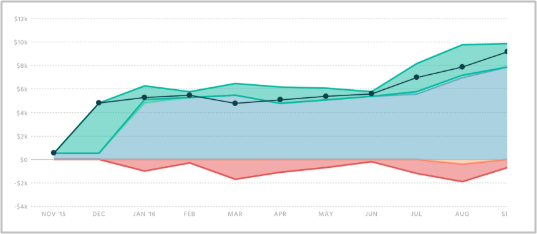
(source: ProfitWell)
It was an exciting ride at the time.
It felt like some sort of break-through in terms of our business model. And it was.
But there were massive problems with the service.
- The scope of work, as in, what we would do and how, at such a low price point, was not well defined at all.
- I tried to hire and train people but, it was difficult to retain talent. We simply could not compensate them enough to where it made sense for them long-term. In addition, the turnover of our team was high.
- Customer churn for the service was high after the three-month mark because the scope of work wasn’t well defined.
Over time my team and I hammered on these problems and things slowly improved. Still, we weren’t profiting much.
My stress levels were through the roof.
I was answering customer emails non-stop. I would write mini-essays in each email. This is because our service said it included strategy, and I wanted to do my best to keep customers happy so they wouldn’t churn.
This business model was brand new to me, so even though we were growing and improving, every cancellation felt like a loss.
A year later I revamped the service completely.
I decided to test making the service be super well-defined and limited in terms of scope.
We would manage customers’ email pop-ups via ongoing AB testing.
This sort of worked, but I wasn’t “into” it and neither was our audience.
Around this time I got out of a bad relationship. Since I was reflecting at this time, I reminded myself of my goal to make the business into a products business, not just a productized service.
I decided then was the opportunity to give that a real try...
Key Lessons:
- If you’re not sure what to do, but know that some parts of your business are working, the least risky thing you can do is to build on top of what works. I got lucky with launching our first productizing service. “Lucky” — because I was talking to customers and members of our audience. You see, we already had lots of traffic related to sales funnels. So, many people in our audience already wanted a service related to that. The funnel service built on what was already working rather than a “Wordpress” service which didn’t align with our audience.
2017: Success, & bootstrapping a digital products business

“It's not that I'm so smart, it's just that I stay with problems longer.” —Albert Einstein
A bootstrapped business means you don’t take outside investment in order to finance a company and grow.
Instead, you are growing from the revenue and profits of customers.
Customers are your investors.
Another fact of running a bootstrapped business is that you have to become profitable almost immediately.
Of course, if you have money saved up, sure, your “runway” is longer.
But no matter what, you can’t lose money forever…
In the first quarter of 2017, I went full-steam ahead with selling products.
I didn’t feel so confident in it though.
 “If you think a thing is impossible, then you will make it impossible.”
“If you think a thing is impossible, then you will make it impossible.”
—Bruce Lee
And in my heart, I wasn’t optimistic at this moment for a few reasons.
First, our runway to get to profitability was short.
We had a couple of clients whose sales funnels we were still managing at the time.
I started reshaping our sales funnel to focus on selling our online course. However, we could never get above ~$2,000 per month, which was the magic number for profitability.
And revenue was completely inconsistent too.
Second, I simply didn’t know what I didn’t know.
And I sort of knew it! :-D
By April of 2017, I could see we were about to run out of cash in a matter of weeks.
So, I stopped working on products and launched a new productized service.
Where as the previous one from 2015-2016 was branded as “done-with-you” — we brand this as 100% done-for-you.
My gut feeling, from talking with past customers is that this is what they secretly wanted.
And we charged appropriately this time to ensure we would accomplish that for our clients. The price was more than 10X higher than the entry-level price for the previous service.
I sculpted the funnel as perfectly as I could, doing my best to define clearly (unlike the previous time) exactly what clients would get.
Then I launched it.
Clients and cash flooded in.
It was exactly what our audience wanted.
I built out our team as fast as possible.
Within two months of launching, we were generating over $19,000 per month (MRR), or about $230,000 annually.
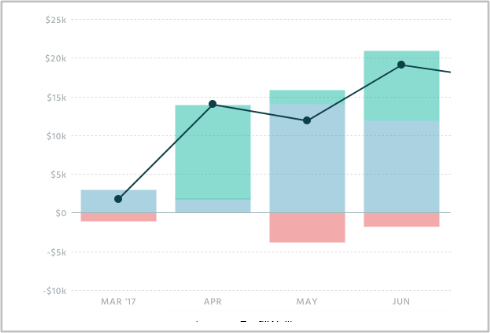
(source: ProfitWell)
The sale wasn’t automated as I had originally hoped. However, our sales funnel was so good, and so well optimized, that I had a 70% close rate when getting on the phone with clients.
It felt good to have a full team of talented people, and to not have to worry about cash flow for a change—to instead focus on delivering our service for clients.
But I hadn’t forgotten about products.
A few months later, after much preparation, we launched our 6-Figure Sales Funnel training.
It was the most successful product launch we had done to date, generating over $5,000 in gross revenue.
The day of the launch, I was getting ready to take my first “real” vacation to the Dominican Republic in years.
My team was set up to handle all our clients, but I wanted to make sure our new product launch was a success.
I worked for 48 hours straight and then slept for a few hours and went back to work.
You might think I felt tired. To the contrary, I felt alive.
Then I hopped on a plane and met up with the girl who would later become my wife in the DR.
While I was on the beach, looking out at a turquoise ocean smoking a cigar with my beautiful lady, I felt my phone vibrating as sales came in.
The business was running, we were making a profit while delivering real value, and we had a full team.
It was a moment of victory.
But it didn’t last.
Because nothing ever does.
And if you ever find yourself thinking “I’ve arrived, I’m finally a success” — you need to slap yourself in the face because it doesn’t work that way.
This following quote is the only enduring and true description in what success really is.
It rings true to me and maybe it will for you as well if you stop to consider it.
2018: Products, 100%.
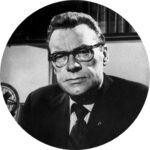 “Success is the progressive realization of a worthy goal or ideal.”
“Success is the progressive realization of a worthy goal or ideal.”
—Earl Nightingale
If your success is based on an impossible image framed for you by others — friends, family, media — then, that can’t be your success.
Because a standard defined by other people and not you is always moving.
It will never be enough.
You will never feel fulfilled because it can never be achieved.
It felt cool to lay on that beach and know we were making money and delivering value.
But I earned that moment. It wasn’t some fantasy.
And quite frankly, doing that for longer than a week would have gotten boring.
My standard of success was and always has been to build a great company that can grow without me.
Our mission has always been: “Accelerate creativity and the entrepreneurial spirit.”
Those things can never be fully achieved, and that’s on purpose.
Nothing can ever be perfect, but it’s about the progress you make towards that standard or mission you set.
I continued working and traveling through Latin America with my future wife for the rest of 2017.
When I was running the business in Costa Rica, I decided the company was close to the point where, coming up soon, I could make another run at the digital products business model.
This time would be different.
We had a bank account full of cash. I had done a good job of managing our profit margins.
We could literally not make a single dollar, and still be fine for at least eight months.
The other thing we had going for us was that we also had a large email list of 12,000+ active email subscribers...
“Your income is directly proportional to the amount of value you deliver.”“The money isn’t in the email list, it’s in the relationship you have with your list.”
—Frank Kern
I laid the groundwork, and by the start of 2018, we’d wrapped up all our client accounts.
We launched our first tripwire in January.
Then launched the Sales Funnel Diagram Pack in April, which was and remains a very popular product.
Over 1,200 copies of both products sold to date.
In our first 10 months as a products business, we sold to 1,600 new customers.
We had a 12% conversion rate from an email subscriber to paying customer.
But it wasn’t all smooth sailing.
I failed to reduce the size of our team soon enough. We simply didn’t need a team of ten people anymore.
Our (cash) burn rate remained much higher than it should have been for that reason.
Revenue kept creeping up, month after month, sometimes tripling or growing by 50%+ from one month to the next.
I shared the journey in monthly growth reports and videos on our blog.
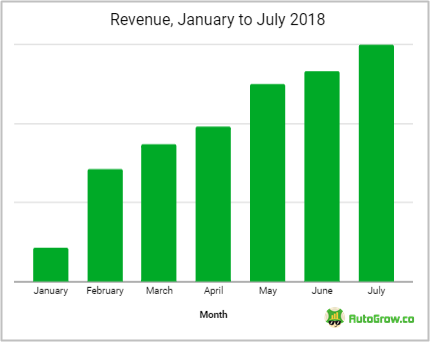
This was great.
But I didn’t know my numbers.
(I recently wrote an article about common start-up mistakes by the way which covers this in greater detail.)
I didn’t know what number exactly we had to reach before we would be profitable.
So we kept burning cash faster than we took it in.
I could have turned off our subscriptions to various tools and web apps we no longer needed—but again, I didn’t know my numbers.
This cost us hundreds if not thousands of dollars.
I was learning rapidly at this time about what it took to run a digital products business.
One clear pattern was that the more emails, content, videos, and launches we did—the more our sales grew.
However, as time went on two things happened…
- I realized I was creating a job for myself.
- The pressure to grow sales month to month became tremendous.
First, although our business was now very “scalable” I found myself working harder and harder for incremental gains.
The business seemed to revolve around how much time I put into it.
That was unexpected.
But it made sense when I thought about it. We’d been charging clients monthly for our service the year before. But now our business model was one-off sales.
There was no recurring component.
And every month we were starting from zero.
Combine that with number two...
Sure, every month we did better, and I’d celebrate that fact and what I learned on video and on our blog.
The truth was, I didn’t want to “fail” publicly. I was a sales funnel expert and if our sales went down for even a single month, this would be really bad… right?
These two things conspired to take me away from developing new products. Instead, I found myself always focused on that last day of the month and getting revenue to be higher before then.
I focused harder and harder on marketing and putting out new offers and content.
It kept working, and I kept doing it.
When in month 8 we finally didn’t grow for the first time—I have to tell you, I actually felt relieved.
I was tired of thinking and investing my effort for shorter term gains.
I wanted to create new products and improve the underlying business model.
2018 overall was a HUGE victory though, despite the challenges.
Compared to revenue from selling our digital products in 2017, we grew by 297% (here’s the article with the full breakdown, published at the beginning of 2019).
Key Lessons:
- Know your numbers, know how much it takes to become profitable.
- Be aware of your systems, and underlying incentives you create for yourself based on those work systems.
- Invest to create long-term value, always.
2019: Rocket Tumbler, and Sticking with it.
The following is a quote from an essay by Steve Jobs, published in Fortune magazine, Jan. 24, 2000:
 When I got started I was 20 or 21, and my role models were the semiconductor guys like Robert Noyce and Andy Grove of Intel, and of course Bill Hewlett and David Packard. They were out not so much to make money as to change the world and to build companies that could keep growing and changing. They left incredible legacies…
When I got started I was 20 or 21, and my role models were the semiconductor guys like Robert Noyce and Andy Grove of Intel, and of course Bill Hewlett and David Packard. They were out not so much to make money as to change the world and to build companies that could keep growing and changing. They left incredible legacies…
But then, the rewarding thing isn’t merely to start a company or to take it public. It’s like when you’re a parent. Although the birth experience is a miracle, what’s truly rewarding is living with your child and helping him grow up.
The problem with the Internet startup craze isn’t that too many people are starting companies; it’s that too many people aren’t sticking with it. That’s somewhat understandable because there are many moments that are filled with despair and agony when you have to fire people and cancel things and deal with very difficult situations. That’s when you find out who you are and what your values are.
So when these people sell out, even though they get fabulously rich, they’re gypping themselves out of one of the potentially most rewarding experiences of their unfolding lives. Without it, they may never know their values or how to keep their newfound wealth in perspective."
2019 is still unfolding.
As I write this, I’ve just turned 32 and April is almost over.
The last eight months of the business have felt up and down.
This is primarily because we’re only at breakeven or making a small profit.
We launched a new product in February called Proven Sales Conversion Pack, which I’m quite proud of.
But I’ve gone back and forth in my mind recently.
Should we go back and launch our done-for-you service again?
Or should I go forward?
But to where? What’s the goal post we’re aiming at next?
For a while, the goal was simply to “get here.”
It was quite painful to burn through the company’s savings, as well as my personal savings in order to make this leap to products in 2018…
To see the numbers evaporate from our bank account month after month (but slowing, as revenue rose).
Then at the beginning of the month, we start from zero again (as I explained above).
It’s tempting to want to go back to what feels “safe.”
I remember when I was in college with my first business.
I got to be somewhat known around campus since my companies made the front page of the newspapers a few times, among other things.
Friends and other students would ask me why I wanted to be an entrepreneur, why take the risk?
Without hesitating I think I’d reply with something like:
“Now is the only time to do it. Life is short. We will all die someday. I have something important I want to contribute before that happens.”
I still feel that way.
I’m reminded of another quote by Steve Jobs, which I’ll embed as a video below.

In the video, Steve tells the story of making friends with a scary old man who lived up the street with him.
He explains how the old man showed him his “rock tumbler.” He’d put rocks he’d collected into it, and it would rotate around. He’d leave it for a few days. When he took them out after that, the rocks would shine like gems.
Steve related this to being in a team of people and working towards a common goal, especially as a startup. The people, he said...
“They polish each other. And they polish the ideas. And what comes out are these really beautiful stones.”
I won’t give up or go backwards. There were well thought out reasons I made the shifts I did in the past.
I’m staying the course.
Because reality is what we make of it.
If I’m honest, things are actually pretty good. We are making a small profit every month.
And that’s coming from unique products I created for our customers, from scratch!
I’m only 16 months into this journey since we transitioned away from the agency model.
My skill set as an entrepreneur and marketer has only grown.
I’ve put in a lot of work and overcome many challenges just to get to this point—and it’s getting better.
You see, I’ve realized that...
Sometimes, reality is a rock tumbler. And the longer you stay in, exposing yourself to the challenges of it, the more polished you get.
And I’m staying in.
So I hope you’ll continue the journey with me too as I reveal the destination we’re climbing toward...
Because success is the progressive realization of a worthy ideal—an ideal that WE get to choose.
The road is bumpy, especially when you do something new—and I’m constantly doing new things as you can see.
Expect the journey to be a challenge.
If you do that, then maybe you won’t be discouraged.
Maybe you’ll be more likely to take action on whatever idea is sailing through your mind right now.
Maybe you’ll enjoy the ride...
And I hope my company and I get the opportunity to be there, right alongside you, helping.
Keep convertin’, stay focused,
![]()













